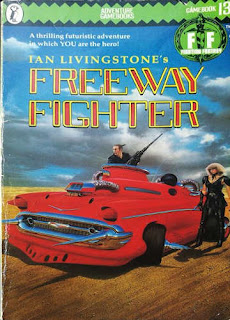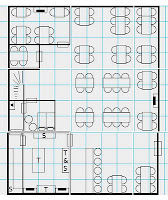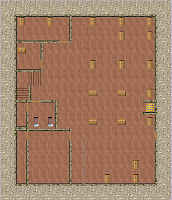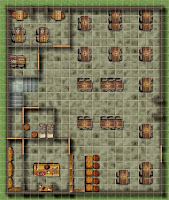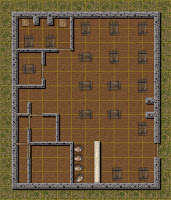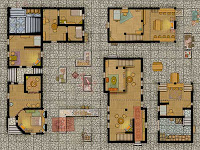Dungeon Maps
These usually conform to the scale of 1 square to 5ft and come in a variety of styles from the original D&D module "Blueprint" style to isometric maps for complex multilevel dungeons. For the purposes of comparison I will attempt to recreate small sections of maps from each of the TSR modules B1 In search of the Unknown (a 2D map) and DL1 Dragons of Despair (a 3D map). Again I am restricting myself to only using free tools or web based apps and from start to finish each map should take no more than 1½ hours to create.
 |  |
| 2D Map Sample | Isometric Map Sample |
Google Sketchup (sketchup.google.com)
Free to use 3D modelling application (Windows/Mac OSX) which has a 2d export function. First thing, make sure that you position the camera to be facing the "Top". Then you can start off by creating a grid (Sketchup is very flexible when it comes to unit measurement so if you want to create 5ft grids do just that, using the appropriate template) it is possible to use the draw line function to draw in all the floors doors and walls. Sketchup is always trying to fill enclosed shapes, so bear this in mind and make sure that when you close a shape you either delete or fill the "face". It isn't really designed to do this, but the learning curve is shorter compared to other free vector graphics tools like inkscape or CC3. Once you have a flat map it's trivial to use the isometric camera and Parallel Perspectives options to turn it into a full 3D map. Extra depth can be instantly added by extruding (google calls this push/pull) a short distance, you can even animate the result (Cue spinning Death Star animation). 7/10 - "Who's The Daddy?"
 | |
| SketchUp 2d Output | SketchUp Isometric / 3d Output |
Tiled (http://www.mapeditor.org/)
This is a free bitmap level editor (Windows / Mac OSX) designed to create level maps for 2d scrolling games and although it's not designed as an RPG mapping tool it is seriously versatile as it supports an unlimited number of user generated layers. However, you do need to supply it with an image of your tiles to begin with so this tool is more of a DIY approach (ie: if you don't have a good bitmap editor then you'll struggle). Here are my classic blue tilemaps if you want to try it out (the tilemaps are set at a size of 50 pixels square). It can do isometrics but I spent far too much time putting the 2d tilemaps together to get round to drawing an iso tilemap, but I'll get there as this tool is just a joy to use.
The interface is really easy to learn and if you've struggled with Pymapper like I did try this with my DT1 tilemap. In my opinion this could also easily replace Dunjinni for Battlemaps, and the ability to have all your objects instantly available in the tileset window is infact a big advantage, so no more struggling to locate that one particular tree which you accidentally loaded into the wrong folder. 9/10 - "The future so bright I gotta wear shades"
 |  |
| Tiled 2d Output | Example of Battlemap Output |
RPG Map Maker X (http://fmteau.perso.neuf.fr/rpgmapmaker/rpgmapmaker.htm)
A Mac OSX native donateware tool ($37 to buy) which has been around for donkeys years. Although the feature set is huge as it has autogenerate dungeons, I found the interface frankly bewildering at almost every stage. The output is also quite primitive in comparison to other free options I tested and given the low pain threshold I have I couldn't even be bothered expend the extra energy to persevere with it beyond the 2d sample. 2/10 - "There's better fish in the sea"
 |
| RPG Map Maker X 2D Output |





